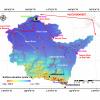Description
Arctic terrestrial ecosystems are very sensitive to the global climate change due to the large storage of soil organic carbon and the presence of snow, glacier and permafrost, which respond directly to near surface air temperature that has warmed in the Arctic by almost twice as much as the global average. These ecosystems play a significant role in affecting regional and global carbon cycling, which have been traditionally quantified using biogeochemical models that have not explicitly considered the loss of carbon due to lateral flow of water from land to aquatic ecosystems. Building upon an extant spatially-distributed hydrological model and a process-based biogeochemical model, we have developed a three-dimensional terrestrial ecosystem model (ECO3D) to elucidate how lateral water flow has impacted the regional dissolved organic carbon (DOC) dynamics in the Tanana Flats Basin in central Alaska. The model explicitly simulates the production, consumption and transport of DOC. Both in-situ observational data and remote sensing-based products were used to calibrate and validate the model. Our simulations show that: (1) plant-litter DOC leaching exerts significant controls on soil DOC concentration during precipitation and snowmelt events; (2) lateral transport plays an important role in affecting regional DOC dynamics; and (3) DOC export to the Tanana River is approximately 9.6 × 106 kg C yr-1. This study provides a modeling framework to adequately quantify the Arctic land ecosystem carbon budget by considering the lateral transport of carbon affected by permafrost degradation. The quantification of the lateral carbon fluxes will also improve future carbon cycle modeling for Arctic aquatic ecosystems.
Cite this work
Researchers should cite this work as follows:
- Liao, C.; Zhuang, Q.; Leung, R.; Guo, L. (2019). Quantifying Dissolved Organic Carbon Dynamics Using a Three-Dimensional Terrestrial Ecosystem Model at High Spatial-Temporal Resolutions. Purdue University Research Repository. doi:10.4231/7YY6-HQ02
Tags
Notes
The dataset can be more easily accessed through the ftp protocol as file 10_4231_7YY6-HQ02.zip on the PURR's FTP server. For instructions how to access the zip file, see https://purr.purdue.edu/kb/projects/access-datasets-using-ftp-client.
